~ 35 ~
~ The Study of Threes ~
http://threesology.org
| Devil's Advocate Series: | ||||||||
|---|---|---|---|---|---|---|---|---|
| pg.1 | pg.2 | pg.3 | pg.4 | pg.5 | pg.6 | pg.7 | pg.8 | pg.9 |
| pg.10 | pg.11 | pg.12 | pg.13 | 14A 14B |
pg.15 | pg.16 | pg.17 | pg.18 |
| pg.19 | pg.20 | pg.21 | pg.22 | pg.23 | pg.24 | pg.25 | pg.26 | pg.27 |
| pg.28 | pg.29 | pg.30 A | pg.30 B | pg.31 | pg.32 | pg.33a | pg.33b | pg.33c |
| pg.34 | pg.35 | pg.36 | pg.37 | pg.38 | pg.39 | pg.40 | pg.41 A | pg.41 B |
There's no sense of me laying in bed or trying to return to sleep when ideas are buzzing about my head. Hence the following (though I will finish working on page 34 in this series later on today):
I have been reflecting on the interjected analogical commentary in which the example of the I-Ching Bigram/Trigram illustration was introduced as a supplementation to the discussion about analog and digital referencing on pages pg.33 a and 33 c in this Devil's Advocate series. The usage of a "Trigram" idea as an embellishment for a pronounced usage of patterns-of-two in the Yin/Yang philosophy clearly suggests that the three-lines arrangement is an extension of the two-patterned idea since only a pattern-of-two lines are used, and not an actual one-two-three lines characterization. Here is the image once again:
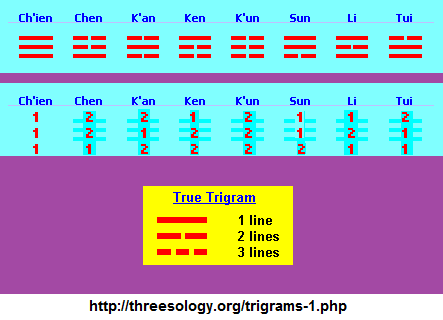
The fact that there are not three lines but only three rows of lines which do not exceed a "two" quantity, expresses an embellished two-patterned orientation that we might interpret as an attempted reaching for a three-patterned point of view. It reminds me of the biological concept of an incomplete metamorphosis described as the three stages of Egg, Nymph and Adult, while a presumed full metamorphosis has 4 stages, that I prefer to interpret as a 3-to-1 ratio since this is a pattern-of-three variation which explains a larger body of similar occurrences in different subjects, and those focusing on only one subject are not particularly interested in looking at their subject by way of examining human cognition from a vantage point of multiple perspectives involving multiple subjects. Most simply repeat what others are claiming in their field of study because that is the flavor, or currency of vernacular being exchanged amongst like-minded peers with the same singular subject focus.
Here is a definition regarding (the dichotomy between) complete and incomplete metamorphosis:
Metamorphosis is the change in the body form and habits during the development cycle of animals. Complete metamorphosis and incomplete metamorphosis are two growth types of insects where the body form of insects changes during their life cycle. Both complete and incomplete metamorphosis extend from the egg stage to the adult stage. Complete metamorphosis consists of four stages: egg, larva, pupa, and adult. However, the incomplete metamorphosis consists of three stages: egg, nymph, and adult. The main difference between complete metamorphosis and incomplete metamorphosis is that complete metamorphosis consists of a very active, ravenously eating larva and an inactive pupa whereas incomplete metamorphosis consists of a nymph, which resembles a miniature adult. Complete metamorphosis occurs in wasps, ants, and fleas while incomplete metamorphosis occurs in termites, praying mantis, and cockroaches
Difference Between Complete and Incomplete Metamorphosis by Lakna Panawala, October 2017
Here is an image with some added commentary speculating about the differences:
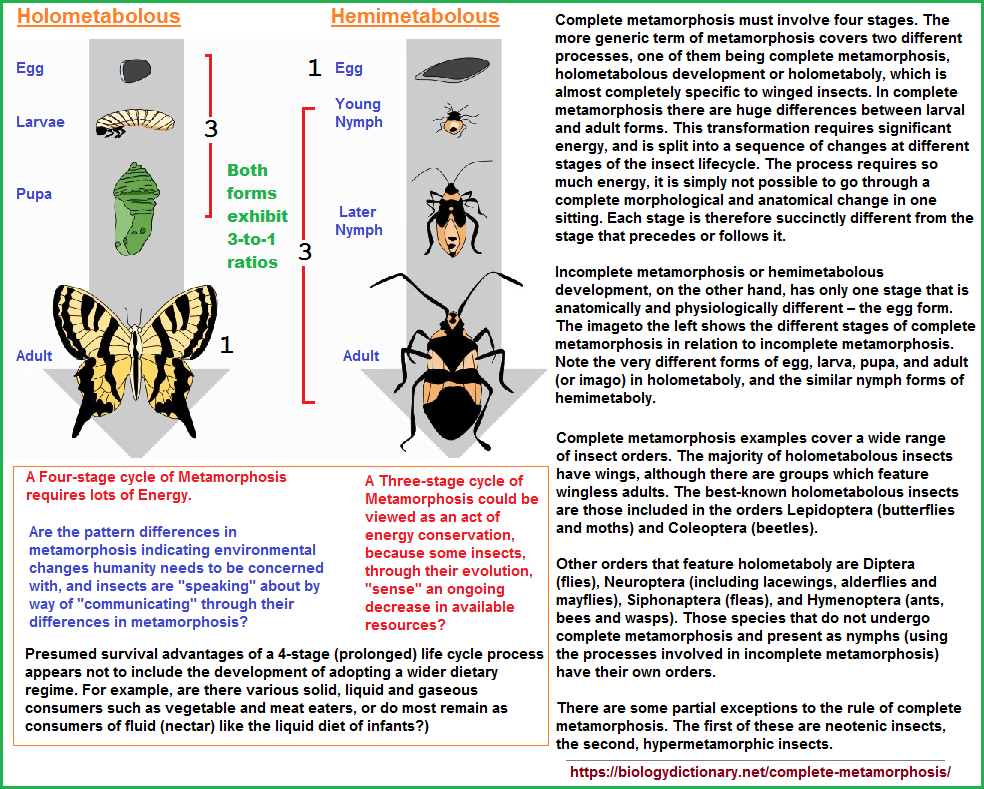
Interestingly, we humans use yet another pattern-of-three organizational methodology to described different types of metamorphosis, and we define the description as a "convenience" instead of recognizing the recurrence as an identifiable characteristic of human cognition, only because "serious" research has not been done, partly because the usage of numbers is subjected to a bipolarism in that it is either held in high esteem and called mathematics or is disparaged by being labeled numerology. Here is a description taken from the Britannica:
Metamorphosis
In biology, striking change of form or structure in an individual after hatching or birth. Hormones called molting and juvenile hormones, which are not species specific, apparently regulate the changes. These physical changes as well as those involving growth and differentiation are accompanied by alterations of the organism's physiology, biochemistry, and behaviour.
The immature forms, or larvae, are adapted to environments and modes of life that differ from those of the adult forms. These differences may be of significance in assuring that larvae and adults of the same species do not engage in direct competition for food or living space. Examples of metamorphosis include the tadpole, an aquatic larval stage that transforms into the land-dwelling frog (class Amphibia). Starfishes and other echinoderms undergo a metamorphosis that includes a change from the bilateral symmetry of the larva to the radial symmetry of the adult. Metamorphic patterns are well-known in crabs, lobsters, and other crustaceans and also in snails, clams, and other mollusks. The larval form of the urochordate (e.g., the tunicate, or sea squirt) is tadpole-like and free swimming; the adult is sessile and somewhat degenerate.
Among the most dramatic and thoroughly studied examples of metamorphosis are the insects. Because development is not the same in all insects, it is convenient to group them into major categories according to the pattern of structural changes: ametabolous, hemimetabolous, and holometabolous. In ametabolous development there is simply a gradual increase in the size of young until adult dimensions are attained. This kind of development occurs in the silverfish, springtail, and other primitive insects. In more advanced insects (e.g., grasshoppers, termites, true bugs) a phenomenon known as gradual, or hemimetabolous, metamorphosis occurs. The hemimetabolous life cycle consists of egg, nymph, and adult. The nymph, or immature insect, resembles the adult in form and eating habits, differing in size, body proportions, and colour pattern. Rudimentary wings are visible and develop externally. Development is gradual through a series of molts (periodic shedding of the outer skeleton), the adult emerging from the final molt.
Complete, or holometabolous, metamorphosis is characteristic of beetles, butterflies and moths, flies, and wasps. Their life cycle includes four stages: egg, larva, pupa, and adult. The larva differs greatly from the adult. It is wingless, and its form and habits are suited for growth and development rather than reproduction. The change to the adult occurs during the inactive, non-feeding pupal stage. At this time the larva undergoes a transformation in which the wings appear externally, larval organs and tissues are broken down, and adult structures are developed. Hypermetamorphosis, a form of complete metamorphosis, occurs in some beetles, flies, and other insects and is characterized by a series of larval stages.
"metamorphosis", Encyclopædia Britannica Ultimate Reference Suite (2013)..
The problem with identifying such occurrence as part of an organism's life development processes, is that we are inclined to attach the idea as solely being representative of that in its context of development, and do not use it as a possible model by which any other thing might occur transitionally, though the specific labeling for the stages may not be usefully applied. Though we recognize developmental milestones in infant development such as speech, behavior, personality development, maturity, education, etc., that are related to what are era-specifically described as normal or customary references to life cycle exhibitions of development (childhood, voice/physical development, high school, college, employment, dating, career, marriage... etc.,), the idea of metamorphosis in terms of segmental representations in speech, ideas, and various symbolic expressions such as a musical composition, art representation, chemical/mathematical formula, etc., does not occur on a regular basis. For example, while if we think about it there does occur metamorphosis in ideas though we do not use the word "metamorphosis", words like revolution, renaissance, restoration, revitalization, resurgence, etc., may be used instead, for larger societal expressions, but individualized expressions may go unrecognized and unlabeled, or overly recognized and either negatively or positively labeled.
While the foregoing is not really a good example in that it is more of a generalization, a more specific example would be in our inability to have established a societal, everyday consideration of "metamorphosis" or transition taking place in day to day ideas and/or speech patterning, not to mention behavioral activity. Whereas we use the idea of "bipolarism" as a negative connotation to behavior that may or may not be a negative activity for a given person in describing a back-and-forth changeability, a word such as "transitioning" is probably more beneficial in understanding human behavior as a species undergoing a long stage of evolutionary development. Evolutionary transitioning can occur with a single individual as it does with the overall species. In other words, Evolution most likely takes place on an individual basis and not en masse. Not everyone is automatically subjected to forces of transition at the same time in the same way, unless of course the force is appreciably dynamic such as an explosion, or some other cataclysm such as a pandemic disease, economic upheaval, etc... A single person can be affected and exhibit effects of evolutionary development which may or may not be outlined in a supposed increase in mental or physical behavior such as an attribute of increased intelligence or physical strength. The effects could be under the skin, so-to-speak in terms of resistance to a given disease, climate, dietary need, etc... However, an individual undergoing an overtly recognizable change in behavior may be stuck in a transition and subjected to a bipolarism of societal forces trying to pull them in both directions at the same time, such as an institution wanting a person to develop in one way and a family wanting them to "return to normal", as each of them are inclined to define normalcy.
Because individuals do not characteristically look for nor are they appreciably aware of the existence of the idea that transitional expressions can take place in individual expressions, including individual works of art, works of mathematics, everyday cooking, gardening, mechanics, etc..., the conscious realization that they are doing something different than they customarily do may give rise to a negative opinion of themselves and defined as being "out of character", craziness, due to something they ate, drank or some other unregularity in their life; whereby they forcibly choose to demand of themselves to exhibit a formally recognized and accepted-as-normal expression, without accounting for small or even large changes as either transitions or a metamorphic emergence of themselves as an ongoing developing individual whose development may take seconds, minutes, days, weeks, months, years or even decades... since individualized developmental phases have their own individualized developmental patterns and time periods.
In these early morning hours my mind traces over the comparison between transitional stages of development for which we have an example of, and the idea of a pattern-of-three exhibiting what I think is an embellishment of a pattern-of-two perspective as illustrated in the so-called trigrams used in the I-ching philosophy. The trigrams are expressing an incomplete metamorphosis into an actual three-patterned perspective, that I am not sure if anyone has actually achieved a full expression of. Indeed, they might appear to be a strange creature to those whose known or unrealized perspective is appreciably two-patterned oriented, with or without the occasional foray into a pattern-of-three realization that may or may not be experienced as a Eureka! moment, in that no doubt some are interpreted in the sense for which their minds are predominantly occupied or preoccupied with, such as someone thinking in relation to a religious trinity, a biological or chemical triple process, a mathematical or musical triad, an artistic three-dimensional expression, a three-tiered meal or speech, a million- billion -trillion economic reference, a triple day workout routine, triple-paced inoculation routine, a three-patterned medical regime, etc...
In short, it may be a present current of activity that the human mind sways back and forth between stages of individual and collective thought processing and perhaps minimal or substantial (sustained) development, that goes unrecognized except in the observation of discrepancies which are concealed by an attempted usage of a digital formula such as occurs in the Title/Prologue- Contents list/Chapters/Scenes (acts) - Ending/Conclusion/Epilogue operations of some expressions. However, let us note that most thoughts and conversations do not become expressed in any digital (or formalized) form, be it an ad, article, student/worker paper, book, journal, etc... And let us not forget to add math and chemistry equations along with drawn-on-the-board sports and other strategies.
Some people do not like to create visual aids because discrepancies can be more easily recognized and corrections made by those who might receive more credit for a proposed idea that was generated by one or two whose process(es) of visualization are more adept in the realm of the analog which remains undigitalized.
However, my current interest is to point out the existence of transitional stages to what may or may not be a full expression, a full metamorphosis into what is presently described as a pattern-of-three perspective, though this too may be but an embellishment of a former stage of thinking that is not an actually obtained full development of thought being considered as a definitive higher stage of thinking. The present pattern-of-three ideology may be just another variation of an embellishment of a lower ideological perception, though it is higher than that which it is embellishing, nonetheless. Many ideas though to be a three, and those being proposed as greater than a three, may be embellishments of that not fully recognized, or perhaps not even labeled appropriately. Hence, it is difficult to imagine, much less discuss the unknown without some means of identifying it as being separate from other ideas if it relies on expressions and illustrations used to identify some lesser perceptions. For example, the X-XX-XXX large sizing which are embellishments of the long established "large" reference. We don't create an actual new idea but instead embellish some presently used or past idea. There is no actual, no real, no new conceptualization. It should also be noted that the American three-patterned usage of small-medium-large is not universally applied through-out the world.
Another example already mentioned, is the difference in endings used for the first three numbers (first, second third), whereas thereafter we repeat ourselves with the "th" (forth, fifth, sixth, etc...), as if our brains fell into quicksand or we are intoxicated, or stepped into an echo chamber. Why is humanity cognitively stuck at the third position, though some might want to argue that the repetition of the "th" means we have moved beyond the "three" but remain at a 4th. My own take on this is that we are confronted by yet another example of the "3-to-1" ratio found in (Biology as Poetry, by Dr. Stephen T. Abedon; and elsewhere: Three to One ratios page A.
Let me take a short escapade into giving some examples of layers and layering, noting that for those who might argue that they kind find examples of fewer or more layers, which is the point to be made about layering... we can and do find instances of different orders in every subject we look at. As such, this widespread usage may well be an expression of an environmentally influenced, biologically-based recurrence that is illustrated in our cognitive designs which can exhibit stagnation, no growth, reversals, intermittent stop and starts, "punctuations", mutations, etc... As well as embellished representations of a former pattern being represented in what is thought to be a more advanced form.
When we discuss layers or layering, one might view it from a geological perspective in terms of the three general layers of the Earth called the Core, Mantel and Crust, or in terms of the 3 rock formations know as Metamorphic (inside the Earth), Igneous (Inside and transitioned externally via volcanoes), and Sedimentary rocks on the surface of the Earth.
Then again, when speaking of layers or layering, one might view it from a particle physicists perspective in terms of the shell model of atomic nuclei in that there are different energy levels.
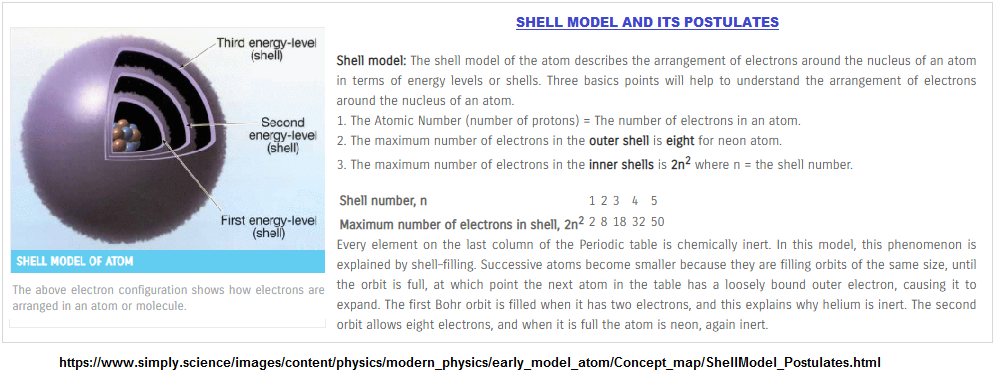
For a more simplified reference to layers or layering, one might think of clothing such as underwear, coats/jackets/shirts, and the shirts/shorts/pants clothing in-between. Of course three-layers of clothing are often called for in cold weather, but in hot weather one may see a variety of three-patterned ensembles such as shorts, undershirt and over-shirt, with or without underwear which may not be included as part of a particular person's clothing orientation in using three items, whether they are conscious of it or not. Then again, as part of someone's wardrobe, they may opt for wearing three-chained necklaces, three types of cosmetics, carry three credit cards, carry a phone, watch and radio, etc... There are also different styles or types of single clothing which can be interpreted as layers, such as the no sleeve, short sleeve and long sleeve shirts, which can be applied to dresses and one might also extend to the overall sizing categories of small-medium-large, though such examples may not be interpreted by some observers as examples of layers... because they are not thinking in terms of cognitive layering that can use sequencing as an expression thereof.




In using the brain as an example of layering (and not described as "tripolarism"), we find three membranes called the meninges (Pia mater- Dura mater- Arachnoid process) surrounding the brain and three main parts called the hindbrain, midbrain, forebrain.
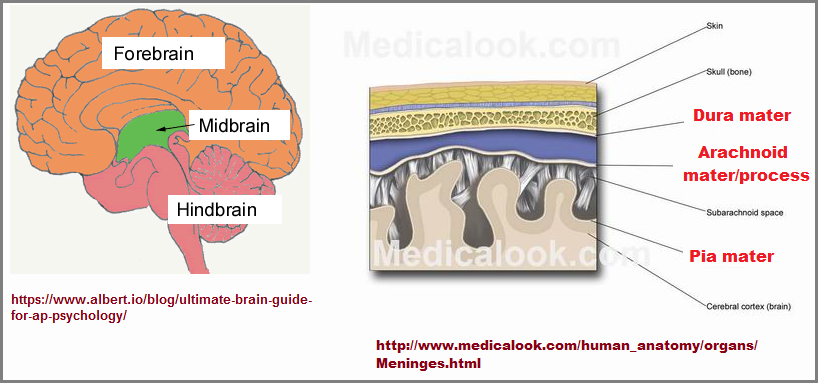
However, before I venture too deep into layering or some other threes referencing sojourn in my overall cataloguing efforts of the larger Threesological project that emphasizes a need to catalogue the presence, absence and intermittent occurrence of threes along-side other patterns, take a look at the following image which is illustrating the word for what most of us might well assume to be a reference to the quantity of "2", but need to keep an open mind since later usage of words may not be how they were initially intended at their origination, since it is quite reasonable to assume that there was a period in which quantity expressed as a linguistic quality was not paired, or shall we say mirror-imaged in a bilateral developmental sense.
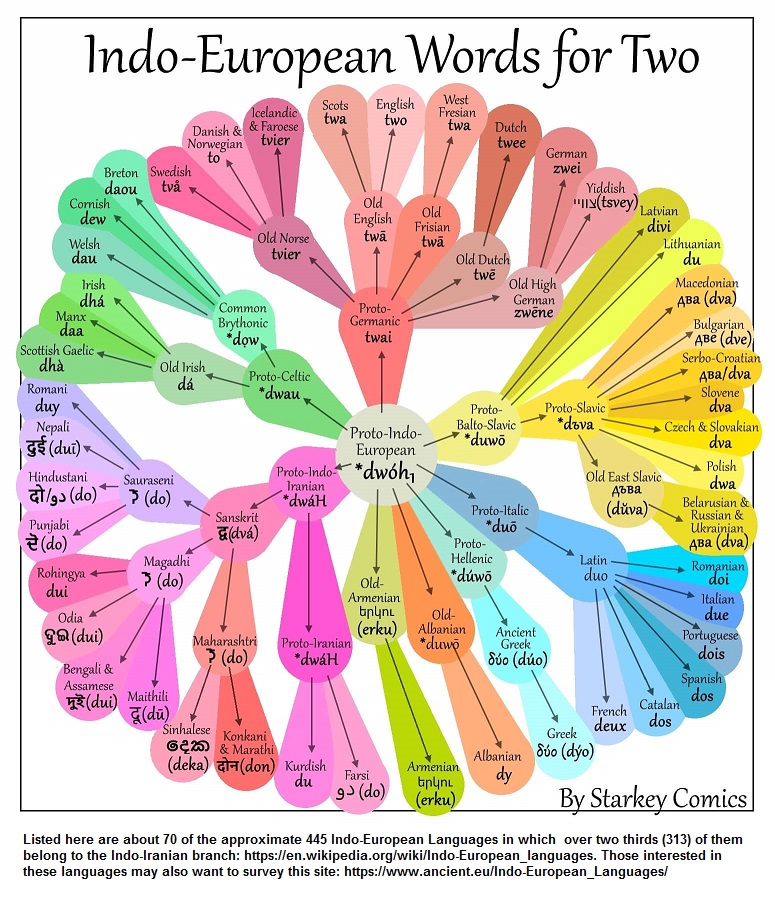
At first glance, when I was sent this via e-mail, the thumbprint image gave me the impression of a color wheel, which may be the primary purpose of the author's intent, with the word references as a type of "word-colored" topping. In other words, the underlying color scheme is the intended main course of perception while the associated words are a sprinkling of added visual flavoring or decoration, a sort of adding a left brain language attribute to a dominant right-brain artistic orientation which provides a means by which those who are either left or right-hemisphere dominant can unconsciously "choose" to focus on one or another "flavor" as an inclined texture they prefer to sample or feast on. Yet, the point in introducing this is to illustrate how a right-hemisphere "two" (see page pg.10 in the present series) can be inter-twined with a left-hemisphere dominant "three" organization, making it difficult for some observers to make a distinction, much less recognize when one or the other is being used as an embellishment to give the impression of greater importance or that some presumed growth is or has occurred.
In the above case, the array of words coupled to the coloring scheme may fulfill some entertainment desire for a few readers, while those inclined towards counting will notice the absence of most of the Indo-European languages and in fact an absence of all the world's languages as a participating characterization of overall human cognition. Nor does it make an attempt to characterize all words, but is selectively oriented towards a "two" reference, whereas there may or may not be an example of like-mindedness with this author for an illustration of any other number-related word. In other words, does the author also have a "color-wheel" for all the numbers up to 10, for example; or has anyone, anywhere created a similar profile for a singular number... though such an illustration has not shown up on a facebook page or perhaps even the internet? In still other words, why focus on "two"? Is it their favorite number or do they have an unrecognized inclination for viewing the world in a two-patterned right-hemisphere dominated way, and not some three contoured embellishment of a right-hemisphere attribute, though the usage of any word for a description of a right-hemisphere attribute might well be a left-hemisphere, three-dominated embellishment thereof.
Indeed, the usage of either words or numbers, as examples of left-hemisphere expressed attributes, may themselves be a stage of human cognitive development in which the once fully dominant right-hemisphere world-view has now moved into a transitional phase of a three-based left hemisphere dominant world-view by the usage of presently designed words and numbers which are currently used expressions of patterns-of-two that are embellished. In other words, the present design and usage of words and numbers may be crude implements of a left hemisphere development still in its infancy, that uses such modes and means like an infant uses babbling. As such, our present words and numbers are babbled expressions that are often misunderstood, though the entire world shares in this same cultural trend of over-all babbling... much like an asylum of crazy people communicating with one another in their own individualized crazy ways, which are collectively shared by way of being labeled subjects, vernaculars, interests, etc... Have you not heard of the expressions such as "Mad Scientist", "Crazed Poet", "Dr. Jekyll/Mr. Hyde", "3 faces of Eve", "Calloused professional", "Battle hardened soldier", "two-faced individuals", mother with "eyes in the back of their heads", the psychotic "it's just business" refrain towards explaining egotism, greed, insensitivity, envy, etc., or the "might is right" slogan, or "manifest destiny" to support colonialization and imperialism, or the irrational justifications for interment of citizens, placing citizens onto reservations, the usage of the military against student protests, armed responses to those striking for better wages, working conditions and shared benefits? No less the craziness of multiple religious leaders and adherents using a made-up text and belief to support whatever inclination a person or group supports in their enclave of rationality?
Let us not overlook the continued existence of rationalized genocides sometimes referred to as "collateral damage" or that serving the greater number sometimes requires sacrifice by one or a few... though others are making the decision of the sacrifice for them without asking for their consent of if some alternative exists. It is not only Socrates who has been forced to drink hemlock, and that his situation is a metaphor to be used in multiple other scenarios because we live in an Age of Irrationality which began with the inception of humanity onto the landscape of Earth.
Before leaving this page, let me also provide another image with information that is not typically viewed in terms of a biological sense related to the idea of layering being described with the notion of metamorphosis, but that the "generations" of atomic matter may be viewed as a complete metamorphosis, unless it too is in a stage of transition and our interpretation of particles and particle arrangement is merely a representation of a transitional stage of development:
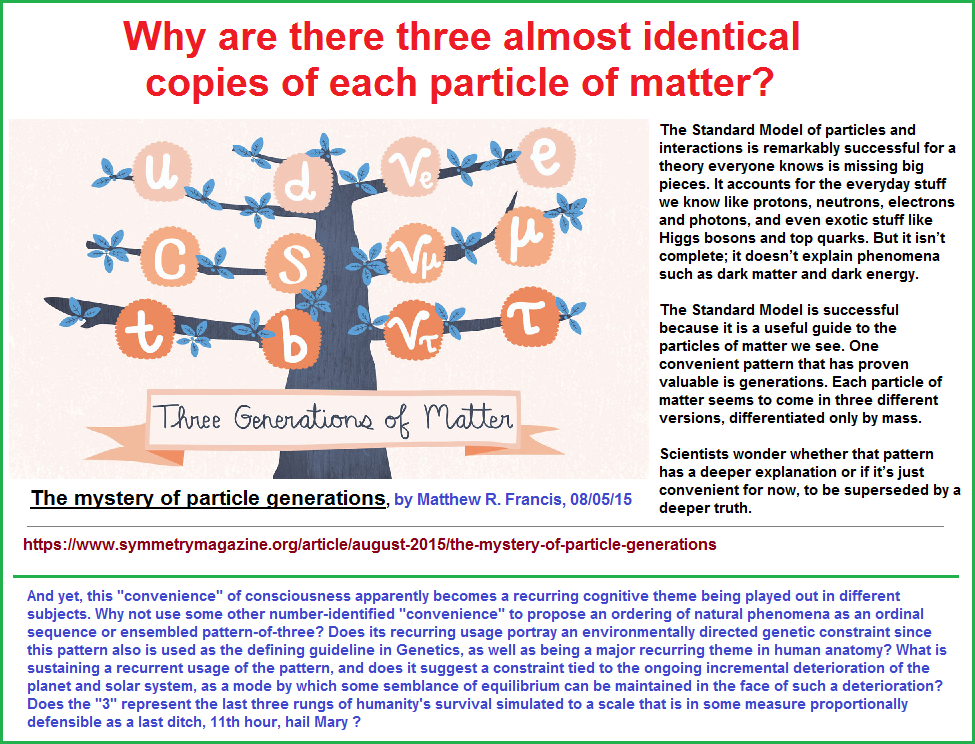
Origination date: Tuesday, October 29th, 2019... 12:48 AM
Initial Posting: Friday, November 1st, 2019... 2:44 AM
Updated Posting: Friday, January 20th, 2023... 12:34 PM
Herb O. Buckland
herbobuckland@hotmail.com